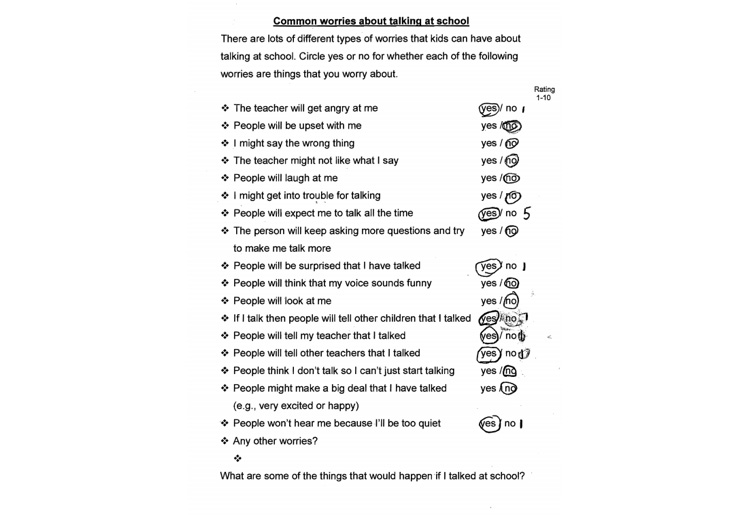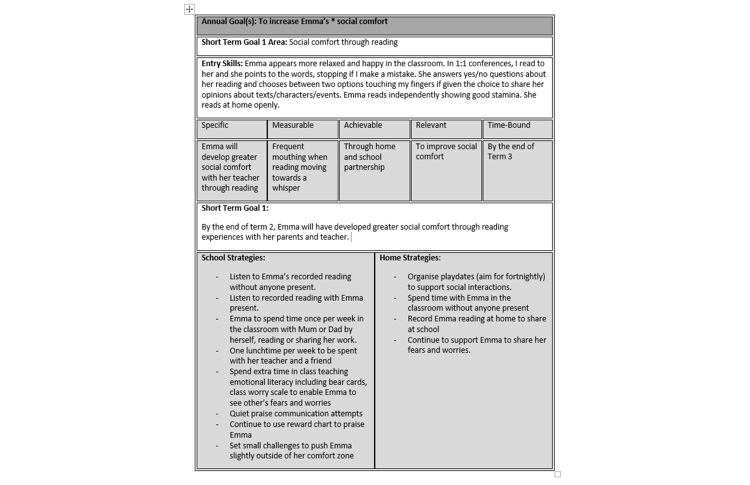Finding Emma's Voice - Teaching a child with selective mutism

Teaching is an awesome profession in so many ways. Sometimes a student comes into your life and you are given a wonderful opportunity to really connect, develop rapport and make a difference.
This is a story about a young student who demonstrated resilience and courage while dealing with anxiety.
I first met Emma* when she was in my Year 1/2 class in 2018. She was in Year One. Her previous teacher shared that she had never spoken at school. I later learned that her ‘selective mutism’, commonly understood to be a form of social anxiety, prevented her from speaking in any situation outside of the house. This certainly piqued my curiosity and I immediately requested a meeting with her parents to find out more.
Term One – Building relationships and researching selective mutism
Term One was spent building a connection with Emma and developing a relationship of safety and trust. I could tell she was bright, she loved learning and had a keen interest in books and reading. I invited Emma and some friends to ‘help’ me with our class library one lunchtime a week, as a way for me to establish a relationship with her outside of the larger classroom group.
I worked on building rapport with Emma’s parents and we communicated often. They shared that Emma was vocal and animated at home. She had two high-ability older siblings, and they all got along very well. Her parents initially thought ‘she would grow out of it’ but were increasingly worried about her selective mutism as Emma grew older. We were all on the same page and ready to try anything. I was motivated by a strong sense that Emma was ready and willing for us to help her.
I noticed a pattern of risk-averse behaviours. Emma would often write unfamiliar words as small as possible, she ‘copied’ ideas for drawings from a friend, and waited for others to make simple choices before making her own. I believed she was scared of making ‘mistakes’ and wondered if this was the cause of her anxiety.
One of the best resources I came across, to help me understand Emma was a simple yes/no survey titled ‘Common worries about talking at school’. From this survey, I established that some of Emma’s greatest worries were; teachers getting angry at her and that if she was to talk, people would tell others and that she would be expected to talk all of the time. She also worried about her voice being too soft.

In order to ensure that all of the staff at the school were aware of Emma’s anxieties and how to support her, I provided them with the information in the table below. I knew it was crucial that all of the people that Emma came into contact with at school understood Emma’s needs and developed a consistent approach when interacting with her.
What you need to know about Emma and how best to support her:
- Emma cannot talk because her nervous system is in freeze mode at school.
- One of Emma’s greatest worries is that the teacher will be angry at her. Be patient!
- Waiting for Emma to speak will cause her great discomfort and it simply won’t happen.
- Ask Emma yes or no questions. If she does not shake or nod her head, avoid putting pressure on her to respond.
- Give Emma two options using your fingers and ask her to touch the finger that represents her choice.
- Quietly praise any communication attempts.
- If Emma does speak, don’t make a big deal…carry on as normal.
- Keep routines as predictable as possible.
- Avoid too much eye contact, it makes Emma feel uncomfortable.
- Pair her with her trusted peers (names provided).
Term Two - An Individual Learning Plan (ILP) in action
Term two began with the goal to increase Emma’s social comfort through reading. I believed this to be the key to helping Emma overcome her fears. I wrote an ILP, shared it with her parents and we got to work
 One morning a week during term two, Emma and her mother would come to the classroom before school started for the day and we worked through the following steps:
One morning a week during term two, Emma and her mother would come to the classroom before school started for the day and we worked through the following steps:
Week 1 – Emma read to her mother at home and it was recorded on video. I listened to the recording outside the classroom, thanking Emma for letting me hear her voice on my return to the classroom.
Week 2 – Again I listened to a recording of Emma reading but this time just outside the classroom.
Week 3 – I listened to this week’s video in the classroom but facing away from Emma.
Week 4 – Emma read to her mother inside an empty classroom.
Week 5 – Emma read to her mother inside the classroom whilst I was sat in my adjoining office with the door closed.
Week 6 – Emma read to her mother as I sat in my office with my back to Emma with the door open.
Week 7 – Emma read to her mother in the classroom. I was present but busy doing ‘things’.
Week 8 – I sat at the end of a table, looking at student workbooks, as Emma read to her mother.
Week 9 – I sat next to Emma and her mother as Emma read.
Final week of term – Emma read to me in the classroom and her mother left when Emma was halfway through the story.
Each week, I would thank Emma for letting me hear her voice and she added a sticker to her chart. This was a simple chart we had created together whereby after collecting ten stickers for communication attempts, Emma was able to choose a ‘reward’ from a stationery prize box.
Emma had begun to mouth words like ‘good morning’, ‘yes’, ‘no’ and ‘thank you’. Any attempts at communication were quietly acknowledged and without fuss. Emma was incredibly proud to privately share with me a video of a puppet show she had performed and recorded at home. I could feel her little body relaxing in 1:1 interactions, and I knew she was feeling more comfortable.
Term Three – Great progress
One strategy from Emma’s ILP was to organise some playdates in different environments with trusted friends. Early in term three, Emma spoke to one of her closest friends on a playdate at the park. They played a game of ‘shops’ and she chatted away all afternoon. Not long afterwards, Emma started speaking to friends in the playground. She began reading to me quietly during guided reading. Emma would put up her hand to answer ‘yes’ or ‘no’ to questions and she shared her ideas in small groups with trusted friends (in a little nook out of the main classroom). Her father joined our parent helpers reading in the mornings and Emma read to him in the classroom.
Around midterm, Emma walked towards me in the playground. ‘Hello Miss Emma’, I said and to my total astonishment, she replied with, ‘Hello Miss Lindau’. Trying to contain my joy was difficult but I managed to keep it cool. Other teachers mentioned she was mouthing ‘good morning’ or ‘hello’ to them and her eye contact and improved level of confidence were also noticeable in her specialist classes. Our lunchtime ‘helping’ sessions continued and Emma began to laugh aloud and answer my questions in this small safe environment. During inquiry play and other low-pressure classroom situations, Emma began to speak freely to her friends. With Emma’s permission, her puppet show video was shared with the class. She received a huge round of applause and coped well with the accolades. Seeing her feel safe and happy was the best reward for all of our hard work.
Term Four – Finding social comfort in other spaces
Emma was talking in the schoolyard and classroom but was yet to feel comfortable enough to speak to other teachers, or in specialist classes. This became the goal for term four. I would pop in to say hello during Art, P.E., Music, and French classes and quietly asked Emma questions, which she answered. It was a positive sign. Slowly but surely, all of the specialist teachers shared with me that she had spoken to them and she began chatting to her friends in their lessons.
Early on in term four, I realised that Emma’s closest friends were all members of the school choir. I commented to her casually one lunchtime that she should join, and that she wouldn’t even have to sing if she didn’t want to. I asked Emma again a week later and she agreed. After two weeks of rehearsals, she began to mouth the words.
To my sheer delight three major breakthroughs, moments I will never forget, occurred in the final week of the school year:
- Emma put up her hand and shared her ideas during a whole-class
- Emma read the role of a ‘mouse’ in a reader’s theatre performance in front of the whole class.
- Emma stood with the school choir on Christmas carols night, in front of the whole school community, and sang!
What happened next?
We started Emma’s transition to her new classroom and teacher early to ensure the momentum continued. I spoke at length with her new teacher about how far she had come and what we had been doing to support her. She entered the new class the following year with some carefully selected friends and spoke from day one.
I no longer teach at the school where Emma attends but email her mother every now and again, and ask teacher colleagues about her progress. Emma is now in Year Four. Whilst shy and softly spoken, she is an active contributor to class and small group discussions. She has a wide social circle and shows kindness and empathy to others. She is doing extremely well academically and is above the expected level in most areas of the curriculum.
Teachers all know the power of connection; it is what drives us in our work. Building connection was central to supporting Emma. By combining this connection with shared goals, parent partnership and collaboration with her teachers we were all able to cultivate an environment of trust and safety for Emma and ultimately help her to find her voice at school.
*Not her real name